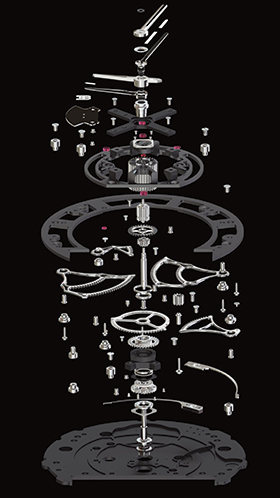
“Begin with something extraordinary, and then go even further with every detail”. That’s how one could describe the concept of car manufacturer, Bugatti. For the display of the upcoming luxury model, Tourbillon, something truly special will be presented. Instead of a digital version, the driver will see a genuine Swiss timepiece behind the steering wheel. The dashboard of the new hyper sports car is packed with the finest mechanics from the workshops of Concepto, where movements for the most prestigious names in the watchmaking world are crafted.
Superlatives wear out quickly when describing the Bugatti Tourbillon. A top speed of 446 kph, acceleration from 0 to 200 in under 5 seconds, and a starting price of €3,8 million are just a few highlights of this car. The drivetrain for the new model, set to launch in 2026, has been completely redeveloped. It is based on a complex system of electric motors, a V16 naturally aspirated engine and the latest generation eight-speed dual-clutch transmission. “It was important to us that this car retains the pure and unadulterated analogue feeling of a combustion engine while also combining it with the agility and capabilities of electric motors,” the manufacturer explains.
Pinnacle of watchmaking
When Bugatti decided to create a mechanical display for its latest vehicle, a highly complex and delicate mechanism was required to compensate for the effects of gravity on the accuracy. Concepto was the natural choice as a technical partner. The car also has a fold-out digital display in the centre console with all the functions expected in a modern vehicle, but the speedometer in the driver’s direct line of sight had to be something truly exceptional.
Dimensional leap and new electronic territory
“Bugatti wanted a display that resembled a high-end Swiss watch on the outside with the same mechanism on the inside,” says Guillaume Tripet, who leads the Bugatti project at Concepto. “From this idea, the concept of a large circular display in the centre with two smaller satellite displays to the left and right was born. It’s reminiscent of a classic wristwatch, and instead of a stopwatch or moon phase, the central vehicle data is displayed along with the exquisite mechanics behind the hands.” The complex movement consists of 600 parts, all of which were developed from scratch as the display required components 80% larger than Concepto’s other watches.
Another challenge was integrating the mechanics with the car’s onboard computer and the electric motors. The vehicle’s drivetrain, fuel and battery data are collected by electronic sensors and sent to the central computer. For this information to appear on a mechanical display, a translator is needed. This task is performed by eight FAULHABER stepper motors. These move the hands by converting the electronic signals directly into precisely counted motor steps.

Highly heat resistant and fast reacting
The pinpoint conversion of control signals into highly precise movements is a strength of all FAULHABER stepper motors. For this project, additional high hurdles in motor selection had to be met. The electromechanical display sits almost freely suspended on the steering column and has only a shallow depth. This limited space, alongside the intricate mechanics, had to accommodate eight stepper motors. The AM0820 and AM1020 models, with diameters of 8 and 10 mm respectively, were selected.
Each motor moves one hand, meaning four motors are housed in the left satellite with its three display elements. These four are the only ones connected to the hands solely via a worm gear, while the other motors have a more complex transmission that is visible through sapphire glass. This component was custom developed by FAULHABER for this application, as was the motor control which translates the measurement signals into hand movements.
“The display must always be easy to read, which is why numerous LEDs are integrated in the cluster,” explains Tripet. “It’s also exposed to direct sunlight in its prominent position, making the inside extremely warm, especially as the limited space only allows for a single ventilation opening. On the other hand, the motors must also operate immediately after starting on a freezing winter day. They must also manage very high loads relative to their small size over long periods and without loss of performance.”
The FAULHABER motors used in the Tourbillon operate in a temperature range from -30 to 120°C. In terms of precision and reaction time, they meet all the requirements set by the Concepto engineers. In pre-production, the drives have already proven that they perform flawlessly.
For more information contact Horne Technologies,

© Technews Publishing (Pty) Ltd | All Rights Reserved